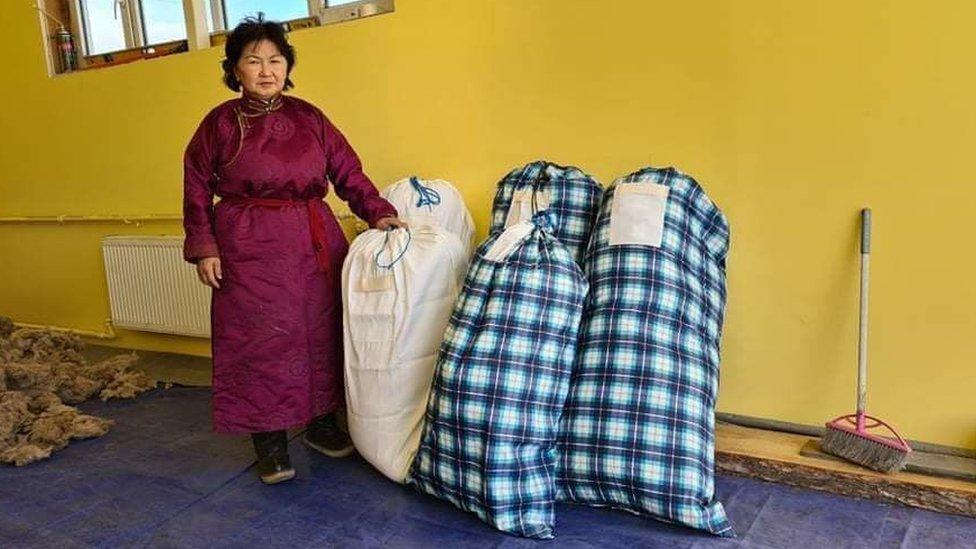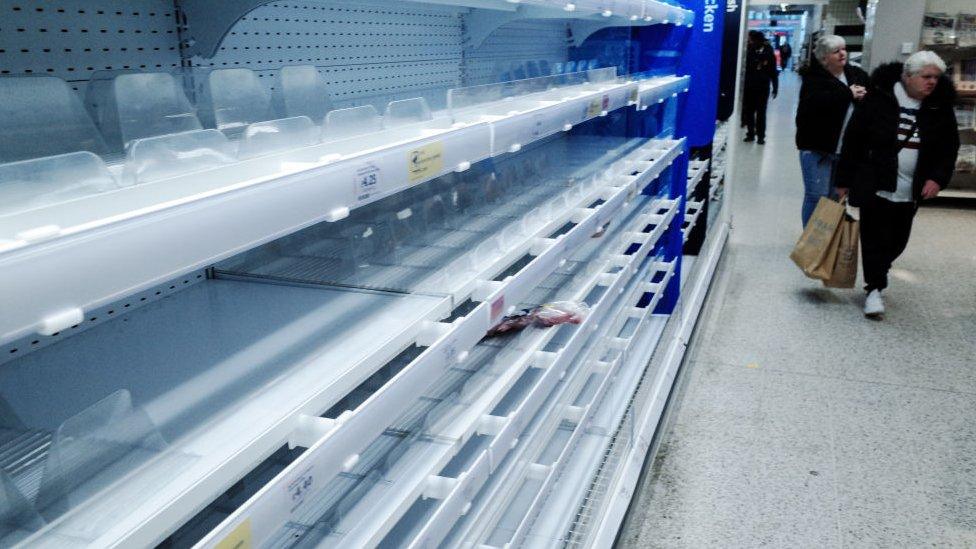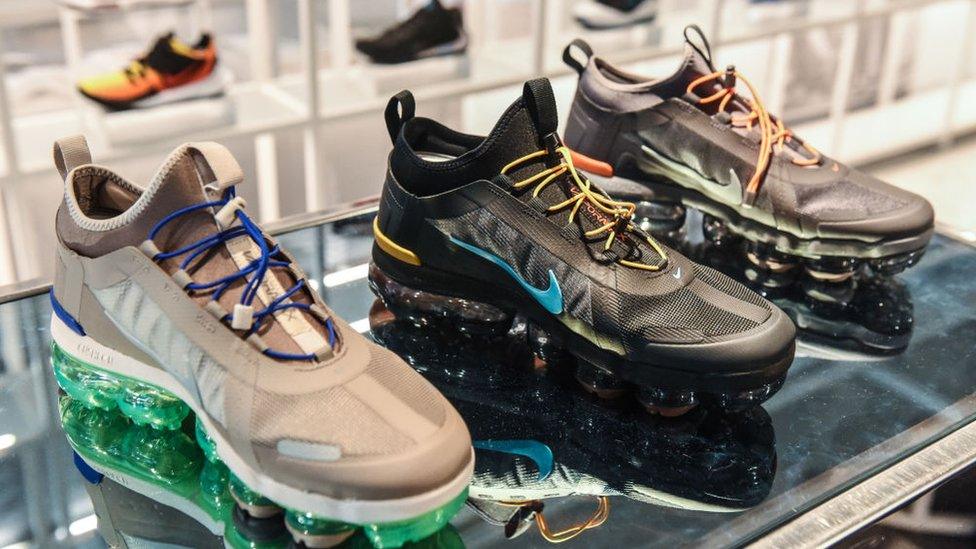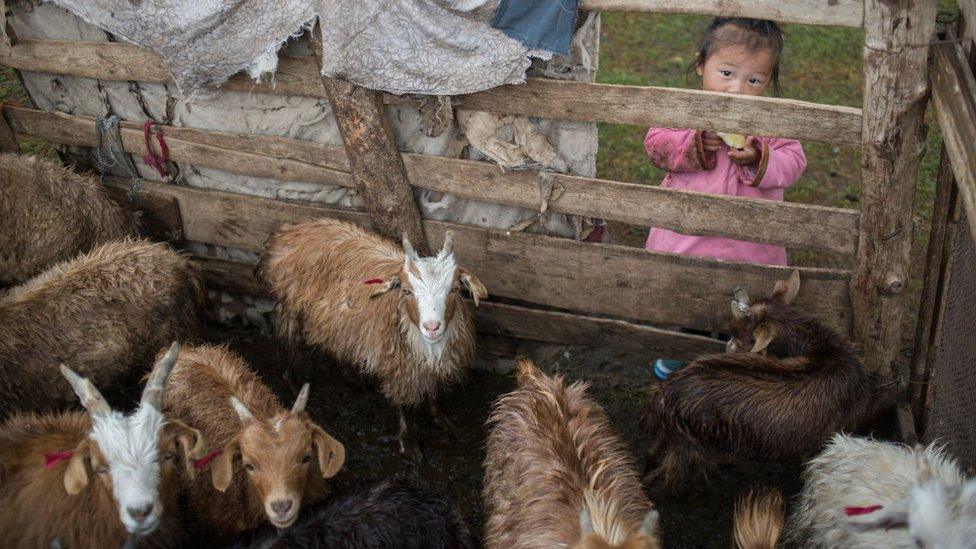'Clothes are torn, worn out - I can't find work gloves'
- Published

Narantsetseg Tsedendorj says that it is hard to find certain items to buy
As she has to endure winter temperatures as low as -30C (-22F), you can understand why Narantsetseg Tsedendorj was concerned about not being able to buy a new pair of gloves.
"Clothes are torn, worn out, I can't find work gloves," she says.
Ms Tsedendorj is a goat herder in the wilds of Mongolia, where she helps the country maintain its position as the world's second-largest exporter of cashmere wool after China.
You might think that her life is a world away from yours, and you'd be right in many ways. But what connects Ms Tsedendorj to most of us is that even in her remote corner of the globe she has been hit by product shortages caused by the coronavirus pandemic.
While most of us saw empty supermarket shelves back at the start of the outbreak last year, for landlocked Mongolia the situation has been more serious, given that it imports so much of its food, fuel and clothing (although obviously not including cashmere) needs.
With the Mongolian government prioritising food imports, it has led to shortages in other areas, and subsequent price rises.
"Mongolia is too dependent on foreign markets, which is very apparent now," says Ms Tsedendorj. "The price of everything has gone up, and I can't find anything to buy."

UK supermarket shelves were stripped bare of many products in March of last year
Global supply chain management is not something most of us ever ponder, unless things go wrong and there are resulting shortages. This has been the case during the pandemic due to lockdowns limiting movements of goods and people, at the same time as people panic-buying.
What can be done to strengthen chains and protect against shortages in the future?
"Many companies were caught out by the pandemic, unfit to deal with the major shock," says Dr Laura Purvis, reader in supply chain management at Cardiff University.
She sites the example of UK supermarkets who stock products according to forecasted demand. "These forecasts are generated a long time in advance, and are tightly managed in order to maximise shelf availability and minimise product obsolescence."
The pandemic saw demand for certain products soar, such as tinned goods and toilet rolls. While other items, such as pre-made sandwiches, saw a big drop as people weren't going out to work. Add a fall in transport, and some supply chains broke down.


New Tech Economy is a series exploring how technological innovation is set to shape the new emerging economic landscape.

Dr Purvis says supermarkets and other retailers need to add their suppliers to a wider, more digitalised supply chain monitoring and feedback system, so data about changes in demand can get back to suppliers far more quickly.
She says this would result in more "transparency", yet she cautions that some retailers are resistant to the idea. "Though the importance of transparency throughout the supply chain is well recognised, it is not always easy to implement.
"Companies can sometimes be reluctant to share information with suppliers, worried they might give away their competitive advantage. And differences in culture, working practices, incompatibility between different computer platforms employed, especially in supply chains that are more global in nature, can all act as barriers to transparency.
"This can leave organisations unable to sense risks in their supply chains, or be late in doing so, leaving them vulnerable."
It is now possible for firms to know the exact location of everything in their supply chain, using barcodes or radio frequency identification, where digital data is encoded in tags or smart labels, she says: "Digitalisation lies at the core of successful supply chains."
Global sportswear giant Nike had already invested heavily in digitalising its supply chain, so when the pandemic struck it was able to quickly react.
It knew exactly where its goods were, and promptly rerouted them from brick-and-mortar stores to warehouses, ready to be sold online.

Nike moved its stock out of stores so it could be sold online instead
A growing number of firms are aiming to follow in Nike's footsteps, according to a February study by accountancy group Ernst & Young., external It found many were looking at artificial intelligence computer systems, plus the use of robots in distribution centres, and drones for deliveries.
Yet technology does not have to be that advanced to strengthen supply chains. For example, when sales of plants and gardening products soared in the spring and summer of last year, the UK garden centre Squire's made regular video calls to suppliers.
"Microsoft Teams meetings have enabled face-to-face updates with suppliers, enabling us to make quick decisions," says Squire's purchasing director Darran Oakley. "There virtual meetings have given us even closer contact with suppliers, strengthening our relationships."
Squire's chairperson Sarah Squire adds that the firm is also trying to shorten its supply chains. "Eighty percent of our plants are grown in Britain, many very locally indeed," she says. "We know that for some other products we need shorter supply lines, and fewer imports going forward."
Susan Lund, lead researcher on trade and globalization at the McKinsey Global Institute think tank, says Covid has caused firms to "look at their whole supply chain from start to finish - to know the full extent of their vulnerabilities".

Sarah Squire says her family-owned garden centre is working on further shortening its supply chains
Chocolate giant Mars has been doing just this. "We are working with our longstanding NGO [non-government organisation] partner, [global poverty charity] Care," says Lisa Manley, vice president of sustainability at Mars.
"We are deploying personal protection equipment, health and safety messaging, food rations, and in some cases, cash, to vulnerable supply chain regions in Africa, Thailand, India and Latin America.
"[And] we have interviewed leaders across agribusinesses and their NGO partners to develop a report on procurement practices that help build supply chain resilience."
A Norwegian firm called Gelato is hoping to improve supply chain resilience by making them much shorter. Its software allows ecommerce makers of physical products such as clothing, wall art, and books to easily connect with manufacturers around the world.
For example, if a British seller of art prints gets an order from a person in Brazil, rather than have to post the item thousands of miles from the UK they can get the artwork printed and delivered by a Brazilian firm.
"The future is about shorter delivery times, lower costs and carbon emission," says Gelato founder and chief executive Henrik Müller-Hansen.

Mongolia has also had to deal with a slump in global demand for cashmere
Back in Mongolia, herders like Ms Tsedendorj have also seen the pandemic hit exports of cashmere, as global demand dipped with fashion stores closed, and people stuck at home cutting back on luxury purchases.
She is hoping that sales of the wool, and supply chains into and out of the country, quickly return to normal. "Living standards have declined, herders are in a difficult situation."
Additional reporting by Will Smale.